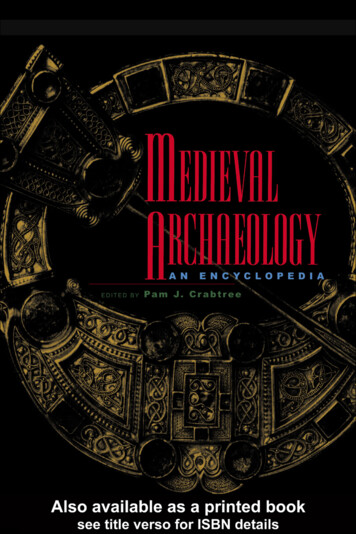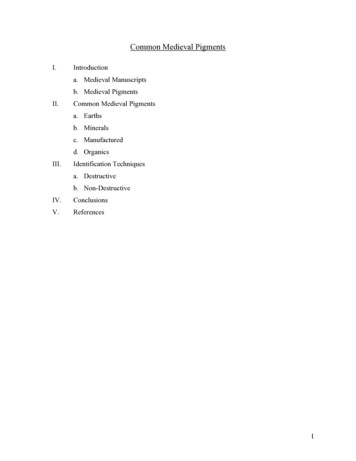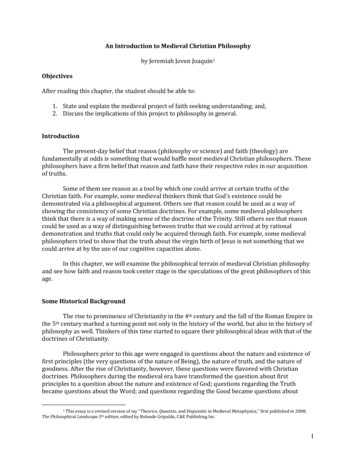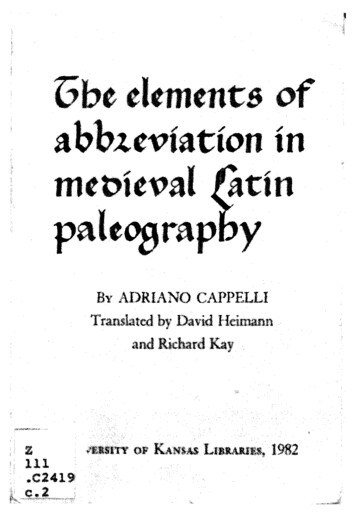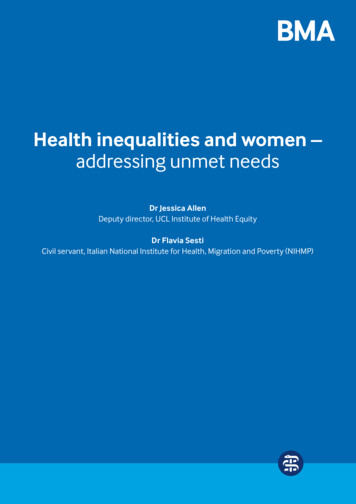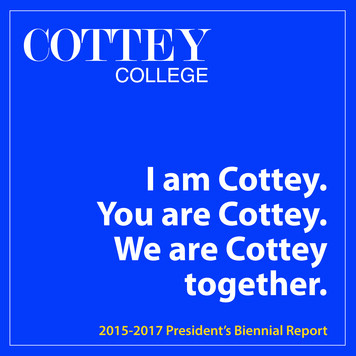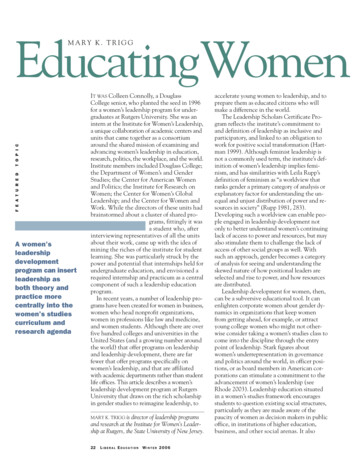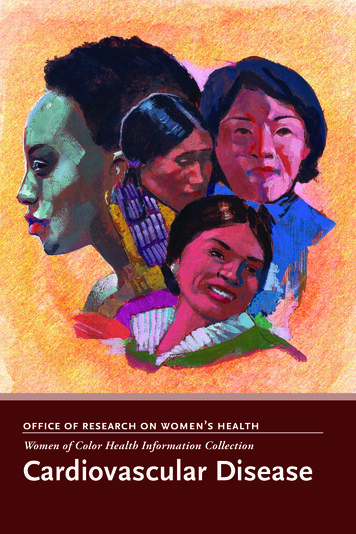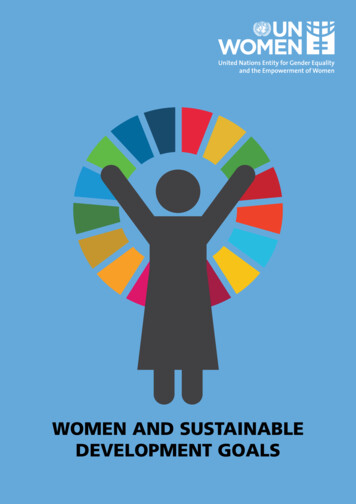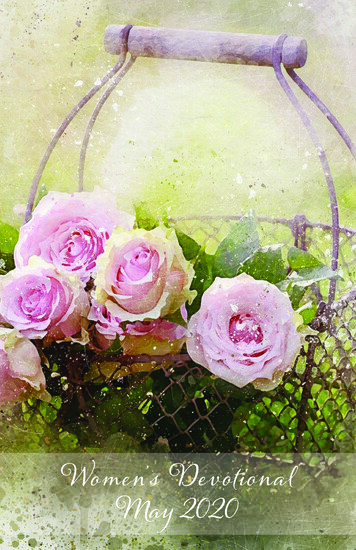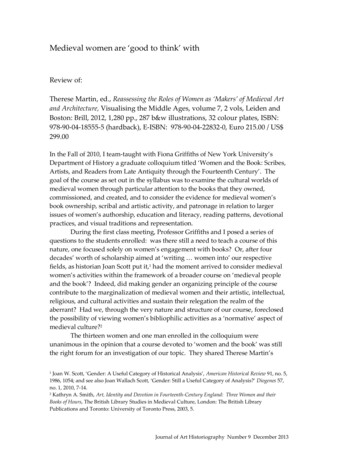
Transcription
Medieval women are ‘good to think’ withReview of:Therese Martin, ed., Reassessing the Roles of Women as ‘Makers’ of Medieval Artand Architecture, Visualising the Middle Ages, volume 7, 2 vols, Leiden andBoston: Brill, 2012, 1,280 pp., 287 b&w illustrations, 32 colour plates, ISBN:978-90-04-18555-5 (hardback), E-ISBN: 978-90-04-22832-0, Euro 215.00 / US 299.00In the Fall of 2010, I team-taught with Fiona Griffiths of New York University’sDepartment of History a graduate colloquium titled ‘Women and the Book: Scribes,Artists, and Readers from Late Antiquity through the Fourteenth Century’. Thegoal of the course as set out in the syllabus was to examine the cultural worlds ofmedieval women through particular attention to the books that they owned,commissioned, and created, and to consider the evidence for medieval women’sbook ownership, scribal and artistic activity, and patronage in relation to largerissues of women’s authorship, education and literacy, reading patterns, devotionalpractices, and visual traditions and representation.During the first class meeting, Professor Griffiths and I posed a series ofquestions to the students enrolled: was there still a need to teach a course of thisnature, one focused solely on women’s engagement with books? Or, after fourdecades’ worth of scholarship aimed at ‘writing women into’ our respectivefields, as historian Joan Scott put it,1 had the moment arrived to consider medievalwomen’s activities within the framework of a broader course on ‘medieval peopleand the book’? Indeed, did making gender an organizing principle of the coursecontribute to the marginalization of medieval women and their artistic, intellectual,religious, and cultural activities and sustain their relegation the realm of theaberrant? Had we, through the very nature and structure of our course, foreclosedthe possibility of viewing women’s bibliophilic activities as a ‘normative’ aspect ofmedieval culture?2The thirteen women and one man enrolled in the colloquium wereunanimous in the opinion that a course devoted to ‘women and the book’ was stillthe right forum for an investigation of our topic. They shared Therese Martin’sJoan W. Scott, ‘Gender: A Useful Category of Historical Analysis’, American Historical Review 91, no. 5,1986, 1054; and see also Joan Wallach Scott, ‘Gender: Still a Useful Category of Analysis?’ Diogenes 57,no. 1, 2010, 7-14.2 Kathryn A. Smith, Art, Identity and Devotion in Fourteenth-Century England: Three Women and theirBooks of Hours, The British Library Studies in Medieval Culture, London: The British LibraryPublications and Toronto: University of Toronto Press, 2003, 5.1Journal of Art Historiography Number 9 December 2013
Kathryn A. SmithMedieval women are ‘good to think’ withconviction, articulated in her introduction to Reassessing the Roles of Women as‘Makers’ of Medieval Art and Architecture, that scholars still approach medieval artand architecture not from a ‘position of neutrality’, but rather from one that regardsthe material as ‘masculine in origin and intent’ and in which women, by virtue ofthe ‘real limits’ to which they were subject in medieval society, ‘play secondaryroles’ (1-2). Moreover, the students concurred with Martin that, in order toappreciate the full range of medieval women’s artistic and cultural activities,scholars must abandon the existing analytic framework by which female patronsand artists are regarded as ‘the exception[s] that prove the rule’ and replace it with anew framework or lens, one through which women’s artistic agency is viewed as a‘new rule waiting to be recognized’ (1). Yet the students also acknowledged thatmedieval women, like Claude Lévi-Strauss’s ‘natural species’, are ‘good to think’with.3 Publications like Reassessing the Roles of Women as ‘Makers’ of Medieval Art andArchitecture force us to examine whether, and how, our ‘operative assumptions’differ when analyzing women’s patronage, consumption, or production of art andarchitecture, as opposed to the activities of men.4 In studying medieval women, wemust continually ask ourselves whether we set the bar at different levels whenevaluating the evidence for women’s and men’s engagement with art andarchitecture, and whether, in every instance, we are justified in doing so.As Martin explains in her ‘Acknowledgements’, Reassessing the Roles ofWomen as ‘Makers’ of Medieval Art and Architecture had its genesis in a graduateseminar she taught at the University of Arizona in 2008. The contours and contentof the collection were shaped by a pair of sessions Martin subsequently convened atthe 44th International Medieval Congress (Kalamazoo, MI), held in 2009 andsponsored by the International Center of Medieval Art (ICMA), and an internationalconference she organized the following year at the Consejo Superior deInvestigaciones Científicas, Madrid, which she joined in 2009 as Científica Titular inthe Instituto de Historia (Centro de Ciencias Humanas y Sociales) (xxxi-xxxii). Thetwo volumes of the collection include, in addition to Martin’s introductory essay,twenty-three substantial chapters treating a millennium of Christian, Muslim, andJewish women’s patronage, production, use, and reception of art and architectureproduced across a broad swath of medieval Europe, including France, the IberianPeninsula, German-speaking regions, Italy, England, Ireland, Scandinavia, and theCrusader Kingdom of Jerusalem. Authored by a distinguished slate of internationalscholars and treating a wide variety of monuments and media, including textiles,metalwork objects, jewellery, religious architecture, castles, tombs, inscribedrunestones, devotional sculpture, and illuminated manuscripts, the chapters arepresented in six broad thematic groups or subdivisions: ‘Display and Concealment’,‘Ownership and Community’, ‘Collaboration and Authorship’, ‘Family andAudience’, ‘Piety and Power’, and ‘Memory and Motherhood’ – although most of34Claude Lévi-Strauss, Totemism, trans. Rodney Needham, London: The Merlin Press Ltd, 1964, 89.Scott, ‘Gender: A Useful Category of Historical Analysis’, 1067.2
Kathryn A. SmithMedieval women are ‘good to think’ withthe essays engage issues that make them relevant to more than one of these thematicgroups.Martin’s wide-ranging introduction, ‘Exceptions and Assumptions: Womenin Medieval Art History’, is indeed fundamentally concerned with medievalwomen’s artistic activities, as its subtitle avers, and it should earn a place amongseveral classic and more recent studies of overlapping subject and scope as a ‘mustread’ on the subject.5 Yet Martin offers fresh perspectives on her topic by focusingnot solely on the status and agency of medieval women but also on the meaningsand uses in the Middle Ages of the Latin verb facere, ‘to make’ (or fecit, ‘made’). AsMartin emphasizes, the artist/patron ‘dichotomy’ is a ‘false’ one in the medievalperiod, and the word fecit as used in inscriptions and other forms of documentation‘ denotes at times the individual whose hands produced the work’ and at othertimes ‘the person whose donation made the undertaking possible’ (2). Deploying astouchstones for her discussion of women’s agency the Eleanor Vase, the inscriptionon which gives precedence to Eleanor of Aquitaine (d. 1204), queen of France andEngland, among that object’s numerous and illustrious, earlier and later owners anddonors, as well as the spectacular chalice given after 1063 to the palatine church ofSan Isidoro, León, by the infanta Urraca (d. 1101), among other works, Martin urgesscholars to consider the full range of women’s strategies of and motivations for artand architectural patronage, and the possibility that ‘the role of “maker”’ can beextended not only to a work’s donor but even to its intended recipient, whosestatus, needs, aspirations, and interests may have been the impetus for the object’screation, donation, or gifting (6). The frescoes of c. 1320 in the Convent of SantaClara in Toro, ‘made’ (fecit) by a certain Teresa Díez, and the images of a male andfemale book artisan at work, found in the lower margins of a mid-fourteenthcentury Parisian Roman de la Rose manuscript artisans identified by Richard andThese include Dorothy E. Miner, Anastaise and her Sisters: Women Artists of the Middle Ages, Baltimore:Walters Art Gallery, 1974; Susan Groag Bell, ‘Medieval Women Book Owners: Arbiters of Lay Pietyand Ambassadors of Culture’, Signs: Journal of Women in Culture and Society 7, no. 4, 1982, 742-68;reprinted in Women and Power in the Middle Ages, ed. by Mary Erler and Maryanne Kowaleski, Athens,GA: University of Georgia Press, 1988, 149-87; Jeffrey F. Hamburger, ‘Art, Enclosure and the CuraMonialium: Prolegomena in the Guise of a Postscript’, Gesta 31, no. 2, 1992, 108-34; Madeline H.Caviness, ‘Anchoress, Abbess, and Queen: Donors and Patrons or Intercessors and Matrons?’, in TheCultural Patronage of Medieval Women, ed. and with an intro. by June Hall McCash, Athens, GA:University of Georgia Press, 1996, 105-54; Annemarie Weyl Carr, “Women as Artists in the MiddleAges: “The Dark is Light Enough”’, in Dictionary of Women Artists, ed. by Delia Gaze, 2 vols, Chicagoand London: Fitzroy Dearborn Publishers, 1997, vol. I, 3-21; Rosamond McKitterick, ‘Les femmes, lesarts et la culture en occident dans le haut moyen âge’, in Femmes et pouvoirs des femmes, à Byzance et enOccident (VIe – XIe siècles), ed. by Alain Dierkens, Stéphane Lebecq, Régine Le Jan, and Jean-MarieSansterre, Villeneuve d’Ascq: Centre de Recherche sur l’histoire de l’Europe du Nord-Ouest,Université de Charles de Gaulle-Lille, 1999, 227-49; Jill Caskey, ‘Whodunnit? Patronage, the Canon andthe Problematics of Agency in Romanesque and Gothic Art,” in A Companion to Medieval Art:Romanesque and Gothic in Northern Europe, 1000-1300, ed. by Conrad Rudolph, Malden, MA and Oxford:Blackwell Publishers, 2006, 193-212; and June L. Mecham, ‘Breaking Old Habits: Recent Research onWomen, Spirituality, and the Arts in the Middle Ages’, History Compass 4, no. 3, 2006, 448-80.53
Kathryn A. SmithMedieval women are ‘good to think’ withMary Rouse as the husband-and-wife team Richard and Jeanne de Montbaston – areamong the works and images that Martin marshals to illustrate the challenge ofrecovering medieval women artists.6In addition, Martin rightly emphasizes the importance of collaboration in themaking of medieval art and architecture, and the greater potential that acollaborative model of production affords for discovering and elucidating women’sartistic activities and agency (31). In several of these thought-provoking andpotentially fruitful moves, Martin’s introduction finds parallels in an illuminatingarticle by Jennifer Summit, who, in considering the question, ‘Were there womenauthors in the Middle Ages?’, challenged readers to shift the ‘burden of proof’ from‘women’ to ‘author’ and ‘authorship’.7 Like Martin, who emphasizes how ill suitedis the post-medieval concept of the ‘great artist’ to medieval artistic production (31),Summit affirms the extremely ‘limited application’ to the medieval evidence of‘modern definitions of the author as an original, self-expressive individual’.8 Onceone allows for the ‘collaborative nature of medieval textual production’ and for theimportance of compilation and tradition to medieval writers; once one takes intoaccount the tendency of medieval women writers (women mystics and visionariesespecially, but also many male religious writers) to employ the language of‘humility’ and ‘self-negation’, along with the particular cultural values medievalwriters assigned to the signature and to anonymity; and once one acknowledges theessential roles of patrons and readers in shaping literary production, one may arriveat a new definition of authorship that encompasses ‘the range of women’s authorialactivities’ in the Middle Ages.9 One need only substitute ‘artist’ for ‘writer’/’author’,‘artistic’ or ‘architectural production’ for ‘textual/literary production’, and ‘viewer’for ‘reader’ here to appreciate the many points of intersection between Summit’sand Martin’s approaches. At the heart of both scholars’ essays are questionsconcerning the nature of authority in the Middle Ages.It is a credit to all of the contributors to Reassessing the Roles of Women as‘Makers’ of Medieval Art and Architecture that they cast their nets widely for evidenceto support their explorations of their material. This is certainly true for two essayson textiles and three concerning architecture whose authors employ a plethora ofapproaches in service of their arguments. As Jenifer Ní Ghrádaigh notes, missingfrom the art historical record are actual examples of high-status textiles made inIreland, whether linen shrouds, liturgical vestments, or embroidered altar cloths;For the Montbastons, see Richard H. Rouse and Mary A. Rouse, Manuscripts and their Makers:Commercial Book Producers in Medieval Paris, 1200-1500, 2 vols, Turnhout: Brepols, 2000, vol. I, ch. 10, ‘A“Rose” by any other Name: Richard and Jeanne de Montbaston as Illuminators of vernacular Texts’,235-60.7 Jennifer Summit, ‘Women and Authorship’, in The Cambridge Companion to Medieval Women’s Writing,ed. by Carolyn Dinshaw and David Wallace (Cambridge, UK and New York: Cambridge UniversityPress, 2003), 91-108, at 91.8 Summit, ‘Women and Authorship’, 91.9 Summit, ‘Women and Authorship’, 91, 105.64
Kathryn A. SmithMedieval women are ‘good to think’ withtheir absence has ‘doomed the discussion of textile descriptions to an obscurity itill deserves (126)’. In ‘Mere Embroiderers? Women and Art in Early MedievalIreland’ Ní Ghrádaigh examines accounts of textiles and their production anddonation found in chronicles, legal tracts, hagiographic works, and poetry, as wellas archaeological evidence, images in manuscripts, and well-chosen comparandafrom Hiberno-Saxon, Anglo-Saxon, and Romanesque art, making a compelling casefor the intimate involvement of both aristocratic laywomen and female religiouswith high-status textiles, and for the close association of embroidery with virtue inearly medieval Irish culture. In contrast to Ní Ghrádaigh’s material, the sevenembroidered objects of Stefanie Seeberg’s attention are extant, although only onehas been the subject of extensive study. In ‘Women as Makers of ChurchDecoration: Illustrated Textiles at the Monasteries of Alternberg/Lahn, Rupertsberg,and Heiningen (13th-14th C.)’, Seeberg mines the historical evidence to construct richcontexts for her analyses of these German figural and narrative embroideries, thefinancing, design, and production of which were the result of collaboration among‘women and men from both within and outside the convent[s]’ (371), and to suggesthow these artefacts were used to promote the memoria of the convents’ keybenefactors and their families and to affirm and broadcast the monasteries’ selfimage. As did Ní Ghrádaigh, Jane Tibbetts Schulenberg interrogates a wide varietyof mainly textual evidence in her article, ‘Female Piety and the Building andDecorating of Churches, c. 500-1150’, including chronicles, cartularies, the vitae offemale saints, and inscriptions and imagery on historiated Romanesque capitals,arguing convincingly for the extensive involvement of women in church-building inthe early Middle Ages, whether as ‘primary agen[ts]’ (249) or as joint patrons withtheir husbands. Annie Renoux’s impressively synthetic ‘Elite Women, Palaces, andCastles in Northern France (c. 850-1100)’ sets out what is known from thedocumentary and archaeological evidence about the ‘place in the power system’ ofqueens, countesses, and noble abbesses, and the nature and extent of their authoritywith respect to the foundation, development, and design of palace and castle sites(741). Renoux concludes that high-echelon women were indeed ‘at the very centre’of power politics in early medieval Francia (754), and that a strong case can be madefor elite women’s activities as having stimulated or established a hospitableenvironment for new developments in castle design, with the tenth and earlyeleventh centuries standing as particularly important moments in this regard. Thepower of one woman – Emma, Countess of Blois (d. 1005), founder in the late tenthcentury of the abbey of Maillezais in western France is the subject of MickeyAbel’s ‘Emma of Blois as Arbiter of Peace and the Politics of Patronage’. Emma’sactivities and persona were the subject of a fulsome retrospective account in achronicle of 1067 authored by the monk Peter of Maillezais. As Abel argues, Peteremphasized the ‘various emotional characteristics’ of the countess’s behaviour,including her ‘states of inspiration (inspirare), wisdom (sapiens), anger (furor), piety(pius), insightfulness (prudens), and strength (potens)’ (829), in order to affirm her5
Kathryn A. SmithMedieval women are ‘good to think’ withpolitical power in the region as well as her role as a mediator of family disputes;analysis of Peter’s narrative and ekphrastic strategies, Abel avers, can shed light onthe political, economic, and social interests and motivations underlying the variousphases of the monastery’s construction (825). There are many threads to Abel’sargument, and the author’s line of thought is at times difficult to follow. Yet Abeldoes succeed in showing how Peter’s various characterizations of Emma – aspuissant aristocrat, pious patron, wronged and wrathful spouse, and ‘inspired’mediator, among other roles and personae – served the monks’ interests in ensuringthe security and prosperity of their community.Among the questions that Martin charged her contributors with consideringis whether there is ‘anything “female” about works made by or for women’ (22).Melissa R. Katz’s essay on the ‘Non-gendered Appeal of Vierge ouvrante Sculpture’opens with an incisive observation on a related issue, namely, that scholars’emphasis on gender ‘as a lens through which to view the production of material art’has resulted in certain works or genres being regarded as ‘inherently gendered’ (39).Accordingly, Katz seeks to revise our picture of the audiences for the Vierge ouvrante(or triptych Virgin or shrine Madonna), a class of sculpture that has been associatedparticularly with cloistered female audiences, first, by means of a critical survey ofthe earlier literature on these compelling artefacts, and second, through anexamination of the evidence offered by Spanish and Portuguese examples, some ofwhich appear to have been commissioned by or for male patrons or monasticcommunities, or which, by virtue of their destinations (parish churches, privatechapels, urban cathedrals, lay confraternities), would have been viewed byaudiences comprising both genders. Readers will find much of value in bothportions of Katz’s essay. Nevertheless, the author might have interrogated herevidence even more deeply in order to explicate the complicated ways in whichgender could, and did, have an impact on viewers’ experience of these works. Katznotes in passing (at 68) that the Benedictine cathedral priory at Durham oncepossessed a large triptych Virgin. Known as Our Lady of Boulton and displayed ina south transept chapel, the sculpture was an important object of veneration forpilgrims travelling to Durham to venerate the shrine of St. Cuthbert and the relics ofthe Venerable Bede, the cathedral’s ‘main attractions’. Yet, even on important feastdays, when the image was opened to reveal a Trinity ‘most curiouslye and fynelygilted’, as the Rites of Durham (1593) describe it, Our Lady of Boulton was accessibleonly to men. Women, who were permitted no further than the west end of the nave,had to be content with viewing in the Lady Chapel two other Marian images,neither of which appears to have had cultic significance.10Not surprisingly, historiography occupies a crucial place in nearly everycontribution to Reassessing the Roles of Women as ‘Makers’ of Medieval Art andArchitecture, including two excellent chapters on French Gothic religiousFor Our Lady of Boulton, see Richard W. Marks, Image and Devotion in Late Medieval England, Stroud:Sutton Publishing Limited, 2004, 198-99.106
Kathryn A. SmithMedieval women are ‘good to think’ witharchitecture. Ellen Shortell’s ‘Erasures and Recoveries of Women’s Contributions toGothic Architecture: The Case of Saint-Quentin, Local Nobility, and Eleanor ofVermandois’ reveals how nineteenth-century restorers’ aesthetic judgements, aswell as their replacement of the heads of female donors with male heads in severalstained glass windows, distorted not merely the appearance but also subsequentstudy of this important Gothic monument. ‘The grand narrative of Gothicarchitecture retains a distinctly masculine character’ (157), as Shortell aptly puts it.Yet after reading Shortell’s accounts of the evidence for women as donors at SaintQuentin specifically and women’s involvement in Gothic building projects moregenerally not only as benefactors but also on the construction site along withher analysis of Eleanor of Vermandois’s political and economic influence in theregion, it becomes eminently possible to imagine medieval ‘women’s actions asessential to the larger [Gothic] project’ (174). Alexandra Gajewski’s ‘The PatronageQuestion under Review: Queen Blanche of Castile (1188-1252) and the Architectureof the Cistercian Abbeys at Royaumont, Maubuisson, and Le Lys’ is both afascinating contribution to the burgeoning literature on the cultural patronage ofmedieval queens and an astute, revisionist account of Blanche’s activities that, likeShortell’s essay, has broad implications for how scholars think about women’scontributions to the history of medieval architecture. As Gajewski observes, thepicture of Blanche in the literature as a ‘munificent, active patron’ (199) ofilluminated manuscripts and stained glass is at odds with accounts of herarchitectural activities, in which the queen and regent is portrayed as playing adistinctly secondary role to her son, Louis IX. Gajewski methodically critiques thepicture of Blanche’s patronal activities, motivations, and taste painted in earlierscholarship, particularly the work of Robert Branner, who framed the ostensiblestylistic ‘austerity’ of monuments with which the queen is associated as a functionand expression of Blanche’s gender and ‘modest’ character, while the moremagnificent, ‘real’ court style monuments are associated with Louis’s ‘kingly’patronage (208).11 In making a case for Blanche and Louis as ‘collaborators inreligious patronage’, for the impact of economics, and for the influence andintervention of ‘clerics, institutions, administrators, and the artist’ (223, 244),Gajewski shows that both the ‘patronage question’ and the style question withrespect to these three royal Cistercian churches are considerably more complex thanpreviously has been allowed.Blanche of Castile is among the best-known royal female patrons inmedieval art history. Less certain are the extent of the artistic activities of Melisende(d. 1161), the daughter and heir, wife, or mother of four kings and queen regnant ofthe Crusader Kingdom of Jerusalem. As Jaroslav Folda notes in ‘Melisende ofJerusalem: Queen and Patron’, the source of this uncertainty is the short biographyof the queen in William of Tyre’s late twelfth-century chronicle, The History ofRobert Branner, Saint-Louis and the Court Style in Gothic Architecture (London: A. Zwemmer Limited,1965).117
Kathryn A. SmithMedieval women are ‘good to think’ withOutremer, which records as Melisende’s sole act of patronage the foundation,construction, and sustained endowment of the female monastery of St. Lazarus inBethany. Drawing on his own foundational scholarship on Crusader art as well asmore recent studies of the queen’s political, religious, and cultural activities, andinterrogating with a fresh eye not only William of Tyre’s text but also royal chartersand the works of art and architecture themselves, Folda argues for Melisende’s‘substantial role in making Jerusalem’ and, by extension, her agency in the creationof ‘a new “Crusader” art starting in the 1130s’ (431). Among the artefacts,monuments, and institutions that Folda links with Melisende as ‘maker’ (using thisterm in the broadest possible sense, as advocated by Martin) are, in addition to thespectacular Psalter of Queen Melisende (London, British Library Egerton MS 1139),long associated with the queen, which Folda maintains was ‘un cadeau expiatoire’given to Melisende by her husband Fulk of Anjou in the context of their 1135reconciliation; the Knights Hospitaller, to which Melisende, jointly with Fulk, madenumerous donations; the Crusader Church of the Holy Sepulcher, the Church of St.Anne, and the Armenian Church of St. James, all in Jerusalem; and the queen’s owntomb in the Valley of Jehoshaphat.Therese Martin’s area of expertise is medieval Iberia, a field to which she hasmade significant contributions in the area of women’s patronage.12 Thus, it is notsurprising to find in Reassessing the Roles of Women as ‘Makers’ of Medieval Art andArchitecture several essays by scholars who study Spain and Portugal. This aspect ofthe collection will be welcome not only to specialists but also to medievalistsworking on other regions of Europe whose familiarity with the Iberian material ismore limited. Moreover, several of these chapters almost certainly will becomestarting-points and touchstones for future scholarship on their topics. One of theseis Miriam Shadis’s excellent ‘The First Queens of Portugal and the Building of theRealm’, which examines ‘the relationship between royal women’s patronage and thefoundation and legitimization of the Portuguese monarchy and realm’ (671).Impressively wide-ranging and brimming with detail and insight, Shadis charts thepatronage of royal women from Teresa (d.1130), daughter of Alfonso VI of León,who inherited the county of Portugal from her father, to Malfada (d. 1256), sister ofAlfonso II of Portugal. As Shadis demonstrates, as royal daughters’ politicalimportance was ‘debilitated’, the nature of their artistic and architectural patronageshifted ‘from the monumental to the personal and the particular’ (691, 693). Evenmore sweeping in scope is María Elena Díez Jorge’s ‘Women and the Architecture ofAl-Andalus (711-1492): A Historiographic Analysis’. The value of this essay lies notonly in its author’s dedication to recovering the overlooked roles played by womenin respect to Andalusi and Mudejar architecture including mosques, palaces,cemeteries, charitable institutions, military buildings, baths, and other public andTherese Martin, ‘The Art of a reigning Queen as dynastic Propaganda in Twelfth-century Spain’Speculum 80, no. 4, December 2005, 1134-71; Therese Martin, Queen as King: Politics and ArchitecturalPropaganda in Twelfth-Century Spain, Leiden: Brill, 2006.128
Kathryn A. SmithMedieval women are ‘good to think’ withprivate structures and spaces – as well as her synthesis and analysis of a trove ofprimary and secondary sources, but also in her incisive observations concerning thelimitations and biases of the sources, which include commemorative inscriptions,legal treatises, payment records, collections of legends, and Arabic poetry producedby both men and women. Glaire D. Anderson’s ‘Concubines, Eunuchs, andPatronage in early Islamic Córdoba’, which treats Umayyad Al-Andalus (756-1031CE), adds a new facet to the lens of gender by considering in tandem the overlookedagency of two important, unfree constituencies of the Umayyad court: royalconcubines and elite eunuchs. In general, as Anderson shows, these groups usedtheir wealth, acquired mainly through gifts from the ruler, to endow charitablefoundations, an activity that provided them or their children ‘with a stable means ofincome’ as well as spiritual and social benefit (665).More narrowly focused than Shadis’s, Díez Jorge’s, and Anderson’s essaysbut no less rich in implication and insight are chapters by Ana Maris S. A.Rodrigues and Felipe Pereda. In ‘The Treasures and Foundations of Isabel, Beatriz,Elisenda, and Leonor: The Art Patronage of four Iberian Queens in the FourteenthCentury’, Rodrigues asks several interconnected questions about her subjects, fourChristian queens of Portugal and Aragón, and the precious objects, buildings, andreligious institutions they commissioned, founded, or endowed. Among thesequestions are: ‘did queens’ art patronage differ from abbesses’ and from otheraristocratic women’s patronage? Did women’s art patronage change according totheir life cycle? Could their patronage be characterized as “female” as opposed tothe patronage of their male counterparts?’ (903). As Rodrigues notes, theparticularities of later medieval Iberian matrimonial law, according to which theseroyal women received dowries from their parents as well as dowers from theirhusbands, meant that their potential as patrons substantially exceeded that ofwomen religious and non-royal women. Moreover, royal women’s authority andcapacity for agency increased with their age: the longer they lived, and especially ifthey became widows and queen-mothers, these women could ‘materialize their ownwishes and create new patterns of spirituality and patronage’ that wereindependent of their husbands’ preferences and activities, and that becametemplates for the patronage of succeeding generations of women (933). The essaysby Rodrigues, Anderson, and Pereda are but three of several contributions toReassessing the Roles of Women as ‘Makers’ of Medieval Art and Architecture in which thepatronal activities of women are shown to have been inflected not only by theirgender but also by their social status and social and familial role(s). In ‘Liturgy asWomen’s Language: Two Noble Patrons prepare for the End in Fifteenth-CenturySpain’, Pereda introduces Mencía de Mendoza (d. c. 1500) and her mother-in-law,Beatriz Manique (d. 1473/74), two influential Castilian noblewomen whosetestaments, among other reco
commissioned, and created, and to consider the evidence for medieval women s book ownership, scribal and artistic activity, and patronage in relation to larger issues of women s authorship, education and literacy, reading patterns, devotional
